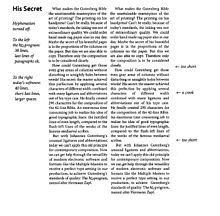Typographic white space

Application area of the hz program : microtypography
The typographic white space or free space is the unprinted part of a printed page; in typography , this now applies accordingly to digital pages.
According to the design principle form-counter-form, the correct division of the printed area into white space represents a creative challenge for the designer.
- In macro typography one speaks of the interplay of image and text with the free space , which itself becomes a design element. A balanced relationship always depends on the content. There are different approaches to achieve this, such as the golden ratio .
- In microtypography , the term white space describes the spaces “on the line”, between and within the characters. By changing the walking distance influence can be taken or the character spacing. In addition, know Unicode and TeX special characters, the different widths Spatien (distances) from the traditional hot type replicate (see General Punctuation ).
A well-set white space improves legibility and requires less concentration for reading. Well structured, it helps the reader to keep an overview and to grasp important content more quickly. This principle also applies to the design of screen content.
